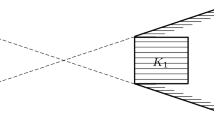Abstract
The main contribution of the paper is the proof that any element in the convex hull of a decomposably antichain-convex set is Pareto dominated by at least one element of that set. Building on this result, the paper demonstrates the disjointness of the convex hulls of two disjoint decomposably antichain-convex sets, under the assumption that one of the two sets is upward. These findings are used to obtain a number of consequences on: the structure of the set of Pareto optima of a decomposably antichain-convex set; the separation of two decomposably antichain-convex sets; the convexity of the set of maximals of an antichain-convex relation; the convexity of the set of maximizers of an antichain-quasiconcave function. Emphasis is placed on the invariance of the solution set of a problem under its “convexification.” Some entailments in the field of mathematical economics of the results of the paper are briefly discussed.
Similar content being viewed by others
Notes
A variant of that definition had already appeared in [14] to prove a fixpoint theorem.
This result has consequences of interest for economic theory. Note, for instance, that Theorem 3.2 allows to generalize Proposition 5.F.2 in [24] by replacing in its statement “convex” with “decomposably \(\mathrm {I\!R}_{+}^{n}\)-antichain-convex” (because any production vector that is profit-maximizing on \({\text {*}}{conv}(Y)\) must be profit-maximizing on Y).
For a concrete example of application of the separation result shown in Remark 4.3, see Theorem 7 in [12] and note that the mentioned separation result can replace part 2 of Theorem 4 in [12] in the proof of Theorem 7 in [12]: in such a proof, at least one of the sets \(\hat{A}\) and B has nonempty interior when V is not finite-dimensional.
Namely, \(h(a)\le h(b)\) for all \((a,b)\in U\times U\) such that \(a\le b\).
When \(V=\mathrm {I\!R}^{n}\), the value of the price functional at the consumption \(x\in X\) specifies the expenditure px given by the scalar product of \(p\in \mathrm {I\!R}^{n}\) and x: the vector p is called a price.
References
Guesnerie, R.: Pareto optimality in non-convex economies. Econometrica 43, 1–29 (1975)
Khan, M.A., Vohra, R.: An extension of the second welfare theorem to economies with nonconvexities and public goods. Q. J. Econ. 102, 223–241 (1987)
Khan, M.A., Vohra, R.: Pareto optimal allocations of nonconvex economies in locally convex spaces. Nonlinear Anal. Theory Methods Appl. 12, 943–950 (1988)
Bonnisseau, J.M., Cornet, B.: Valuation equilibrium and Pareto optimum in non-convex economies. J. Math. Econ. 17, 293–308 (1988)
Khan, M.A.: The Mordukhovich normal cone and the foundations of welfare economics. J. Pub. Econ. Theory 1, 309–338 (1999)
Mordukhovich, B.S.: An abstract extremal principle with applications to welfare economics. J. Math. Anal. Appl. 251, 187–216 (2000)
Bonnisseau, J.M.: The marginal pricing rule in economies with infinitely many commodities. Positivity 6, 275–296 (2002)
Flåm, S., Jourani, A.: Prices and Pareto Optimization. Optimze 55, 611–625 (2006)
Florenzano, M., Gourdel, P., Jofré, A.: Supporting weakly Pareto optimal allocations in infinite dimensional nonconvex economies. Econ. Theory 29, 549–564 (2006)
Jofré, A., Rivera, J.: A nonconvex separation property and some applications. Math. Program. 108, 37–51 (2006)
Habte, A., Mordukhovich, B.S.: Extended second welfare theorem for nonconvex economies with infinite commodities and public goods. In: S. Kusuoka, T. Maruyama (eds.) Advances in Mathematical Economics, pp. 93–126. Tokyo (2011)
Ceparano, M.C., Quartieri, F.: A second welfare theorem in a non-convex economy: the case of antichain-convexity. J. Math. Econ. 81, 31–47 (2019)
Border, K.C.: Fixed Point Theorems with Applications to Economics and Game Theory. Cambridge University Press, Cambridge (1985)
Ceparano, M.C., Quartieri, F.: Nash equilibrium uniqueness in nice games with isotone best replies. J. Math. Econ. 70, 154–165 (2017)
Jofré, A., Jourani, A.: Characterizations of the free disposal condition for nonconvex economies on infinite dimensional commodity spaces. SIAM J. Optim. 25, 699–712 (2015)
Starr, R.M.: Quasi-equilibria in markets with non-convex preferences. Econometrica 37, 25–38 (1969)
Ekeland, I., Témam, R.: Convex analysis and variational problems. SIAM 56, 988 (1999)
Khan, A.A., Tammer, C., Zălinescu, C.: Set-valued Optimization. Springer, Berlin (2016)
Sawaragi, Y., Nakayama, H., Tanino, T.: Theory of Multiobjective Optimization. Elsevier, London (1985)
Jahn, J.: Vector Optimization. Springer, Berlin (2011)
Luc, D.T.: Theory of Vector Optimization. Springer, Berlin (1989)
Eichfelder, G.: Variable Ordering Structures in Vector Optimization. Springer, Berlin (2014)
Mordukhovich, B.S.: Variational Analysis and Applications. Springer, Berlin (2018)
Mas-Colell, A., Whinston, M.D., Green, J.R.: Microeconomic Theory. Oxford University Press, New York (1995)
Kelley, J.L., Namioka, I.: Linear Topological Spaces. Graduate Texts in Mathematics. Springer, New York (1963)
Giannessi, F.: Constrained Optimization and Image Space Analysis, Vol. 1: Separation of Sets and Optimality Conditions. Springer (2005)
Polyrakis, I.A.: Demand functions and reflexivity. J. Math. Anal. Appl. 338, 695–704 (2008)
Acknowledgements
The authors would like to thank the reviewers, an Associate Editor, and an Editor-in-Chief, for valuable suggestions which improved the paper.
Author information
Authors and Affiliations
Corresponding author
Additional information
Communicated by Xiaoqi Yang.
Publisher's Note
Springer Nature remains neutral with regard to jurisdictional claims in published maps and institutional affiliations.
Rights and permissions
About this article
Cite this article
Ceparano, M.C., Quartieri, F. On Pareto Dominance in Decomposably Antichain-Convex Sets. J Optim Theory Appl 186, 68–85 (2020). https://doi.org/10.1007/s10957-020-01696-9
Received:
Accepted:
Published:
Issue Date:
DOI: https://doi.org/10.1007/s10957-020-01696-9




